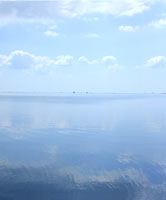Linking a Conceptual Karst Hydrogeologic Model of the Biscayne Aquifer to Ground-Water Flow Simulations from Everglades National Park to Biscayne National Park-Phase 1
|
Project Investigator:
Kevin Cunningham
Project Personnel: Melinda Lohmann, Chris Langevin, Michael Wacker, G. Lynn Wingard, Edward Robinson, Joann Dixon, Lee J. Florea, Michael C. Sukop, Pedro F. Alvarez, Haibo Huang, Barclay Shoemaker, H. Allen Curran, Cameron Walker Project Start Date: 2005 End Date: 2009 Recent Funding: (FY08) ENP CESI, USGS GE PES, (FY07) ENP CESI, USGS GE PES, (FY06) ENP CESI, USGS GE PES |
| Summary |
| The objectives of this project are to: (1) build on the Lake Belt area hydrogeologic framework; and (2) develop procedures for numerical simulation of ground-water flow within the Biscayne aquifer multi-porosity system. |
Research is needed to determine how planned Comprehensive Everglades Restoration Plan (CERP) seepage control actions within the triple-porosity karstic Biscayne aquifer in the general area of Northeast Shark Slough will affect ground-water flows and recharge between the Everglades wetlands and Biscayne Bay. A fundamental problem in the simulation of karst ground-water flow and solute transport is how best to represent aquifer heterogeneity as defined by the spatial distribution of porosity, permeability, and storage. The triple porosity of the Biscayne aquifer is principally: (1) matrix of interparticle and separate-vug porosity, providing much of the storage and, under dynamic conditions, diffuse-carbonate flow; (2) touching-vug porosity creating stratiform ground-water flow passageways; and (3) less common conduit porosity composed mainly of bedding plane vugs, thin solution pipes, and cavernous vugs. The objectives of this project are to: (1) build on the Lake Belt area hydrogeologic framework (recently completed by the principal investigator), mainly using cyclostratigraphy and digital optical borehole images to map porosity types and develop the triple-porosity karst framework between the Everglades wetlands and Biscayne Bay; and (2) develop procedures for numerical simulation of ground-water flow within the Biscayne aquifer multi-porosity system.
Work Plans
Project Summaries
Metadata
- Linking a conceptual karst hydrogeologic model of the Biscayne aquifer to ground-water flow simulations from Everglades National Park to Biscayne National Park - Phase 1 (project metadata)
Publications
Animations
Open File Reports
- U.S. Geological Survey Science Support Strategy for Biscayne National Park and Surrounding Areas in Southeastern Florida (OFR 2007-1288, available from the U.S. Geological Survey website)


 3-D animated fly-through of a very well-connected touching-vug burrow porosity from the upper part of the Biscayne aquifer in Miami-Dade Co.
3-D animated fly-through of a very well-connected touching-vug burrow porosity from the upper part of the Biscayne aquifer in Miami-Dade Co.